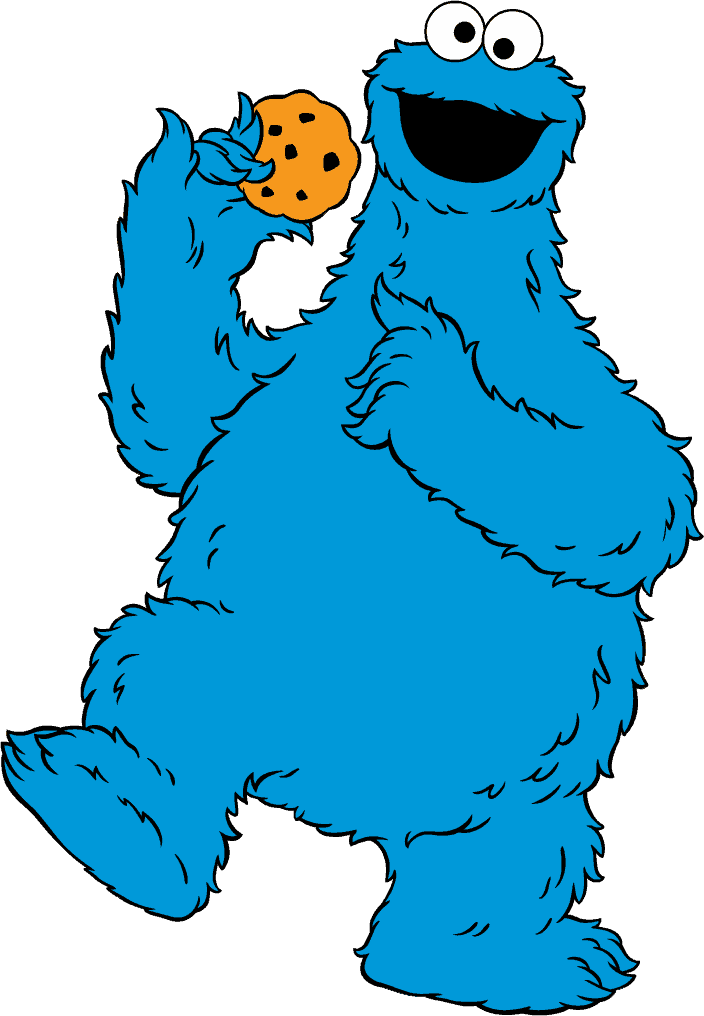If you’ve been in digital marketing for more than 1.7 hours, you’ve probably heard this.
- Tell stories!
- Stories sell things!
- Learn how to tell stories
- yada yada yada
If you’re anything like me, you’ve probably been left wondering what does “tell stories” really mean, and how on Earth do I actually DO that??”
Well, no more.
In this post, we’ll be diving into
- How you can USE stories in your content (to sell products & ideas)
- HOW TO ACTUALLY TELL STORIES.
Here’s the first part of this podcast series:
or listen on Apple Podcasts \ Google Podcasts \ SpotifyOk, so once upon a time…
What does “tell stories” even mean?
You’re probably thinking I’ll dive into some complex marketing and sales strategy here.
Nope.
I mean actual stories.
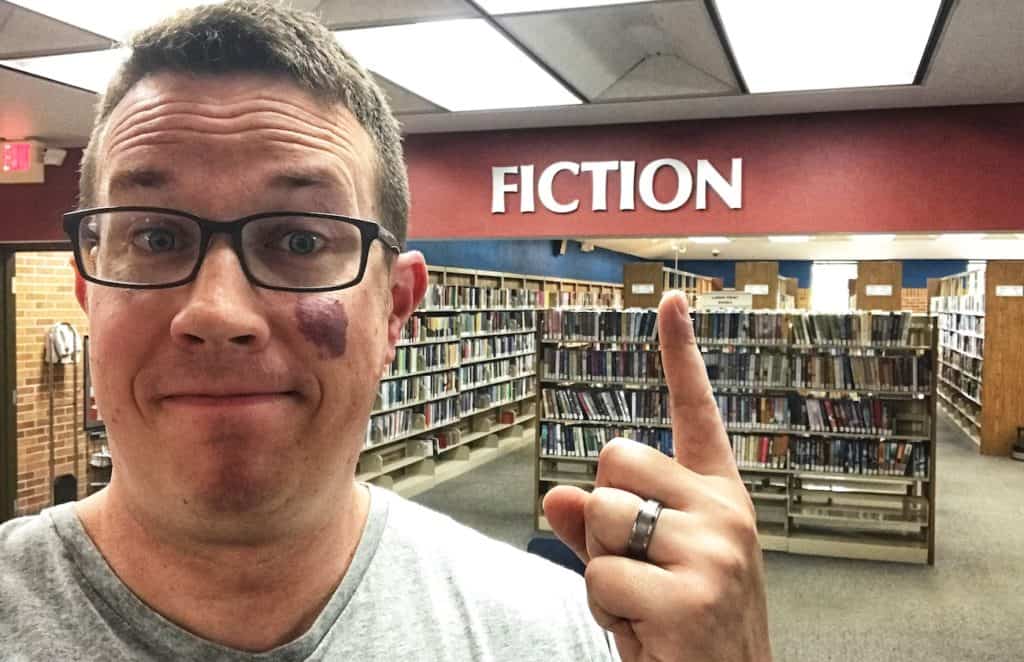
- A character
- Who wants something
- But there’s a nasty villain
- So they go on a journey
- And something happens
We’ll be talking about a traditional “story” in this blog post.
Because it’s exactly those types of stories we can adapt to create insanely engaging content and sell our info products ????
You’ll learn how to do that in a minute.
So what exactly is a story?
The telling of an event (a real or made up one) for the purpose of experiencing or learning something.
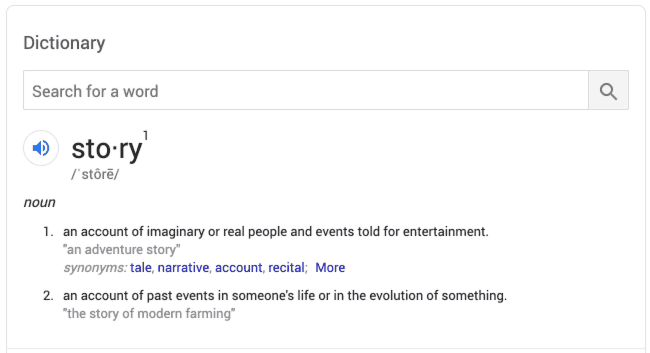
Movies. Fairy tales. Books.
A story is a telling of something that happened–and why we should care.
How can we use stories in marketing?
Yay! I’m glad you made it this far in the post–as this section will make you money ????:)
Think about it like this…
- Marketing = the act of communicating important messages about products
- Communicating messages = requires engaging the audience
- Stories = THE most engaging form of communicating
As humans, we can’t help but be drawn into stories. They engage our brains.
There’s an awesome article in The Atlantic that shows why this might be.
“A narrative works off of both data and emotions, which is significantly more effective in engaging a listener than data alone.“
Pretend we’re buddies who work together, and I wanted to warn you about a busy street. I could say…
“The street just outside our building is really busy today. Be careful when you cross it.”
You might find that data useful. But what if we attach some form of story to it?
“Did you hear Joe went for coffee this morning and was hit by a car just outside? Broke his leg. That street is busy today. Be careful when you cross it.”
Not only is there now more emotion involved, but you might actually be able to “put yourself in the shoes” or our poor friend who was hit.
Storytelling works.
Here’s the huge point:
Your audience is CONSTANTLY being interrupted with ads, sales emails, new podcasts, blogs, and online courses. If you want your message to BE HEARD, you’ll need to keep people engaged. Using stories (or even different elements from stories) is an effective way to do that.
Re-read that. ????
Now let’s learn how to tell stories.
The 10 “Story Lego” Building Blocks You Can Use to Create a Story
Think of a story like a lego project.
It’s really just a sum of several smaller components (which you’ll learn in a second).

You can assemble to blocks in several ways.
- You can assemble the blocks sequentially, or
- You can pick and choose different blocks to suit your different needs!
Super important Note:
You do NOT need every block to make a story (except maybe the first three)!
Pick and choose from these Story Legos to tell the story you need to tell.
1. The Main Character
- Star Wars = Luke Skywalker
- Toy Story = Woody
- Jaws = Chief Brody
- Titanic = Rose
Every story needs a focal point, and that’s usually the main character.
Donald Miller (of StoryBrand) says that we should position our customers (or readers) as the hero in our marketing story, not our brand.
We’ll dive into this in the “brand story” section below…
2. The Chasm
This is a chasm ????
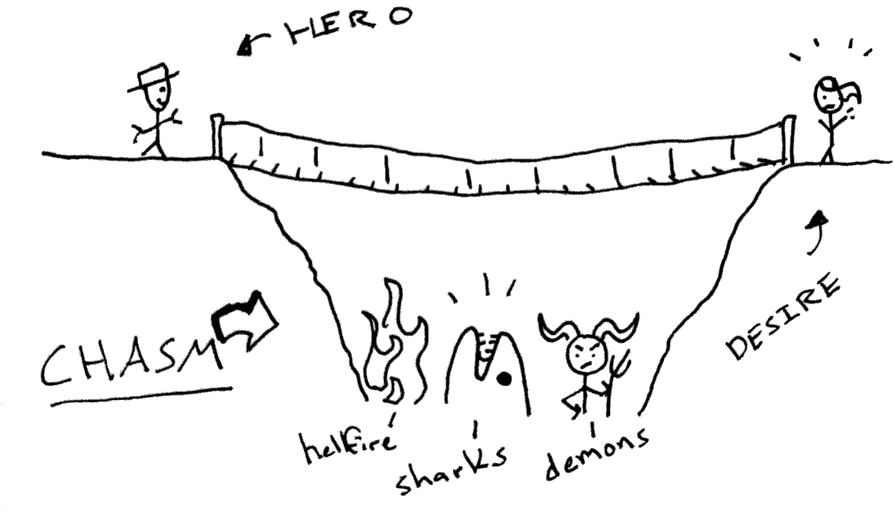
This is also known as a story gap–and it basically just means “the gap between the hero and what the hero wants!”
Chasms leave an audience wondering “will the hero get what they want??? What will happen???”
Chasms are actually a byproduct of the next three Story Legos!
3. The Stakes
Why does the chasm even matter?
- What if Chief Brody gets eaten by the shark, and the shark continues on a rampage?
- Will Luke fail, leaving the evil Emporer to suppress freedom across the galaxy?
- Will Rose be stuck in a life she hates?
What are the stakes?
If there is no downside to the hero FAILING or getting killed–your audience won’t be engaged.
4. The Desire
In order to create a chasm, the main character needs to desire something.
Important marketing tip:
All heros actually want TWO things (and so do your customers):
- The obvious thing
- The internal thing
The obvious thing = Luke wants to defeat the empire.
The internal thing = Luke wants to overcome his self-doubt and prove to himself that he has what it takes.
Your customers might want to make more money, or get a better job, or pay off student loan debt…
…but what they actually want is to feel comfy, secure, and stress-free about their money.
Jason Bourne wants to find his identity. Simba wants to return to Scar to avenge his father’s death and claim his kingdom.
The hero has to want something, but there has to be an obstacle to create a chasm.
5. The Problem
If the hero could simply cross the bridge and get exactly what they want–what kind of story would that be?
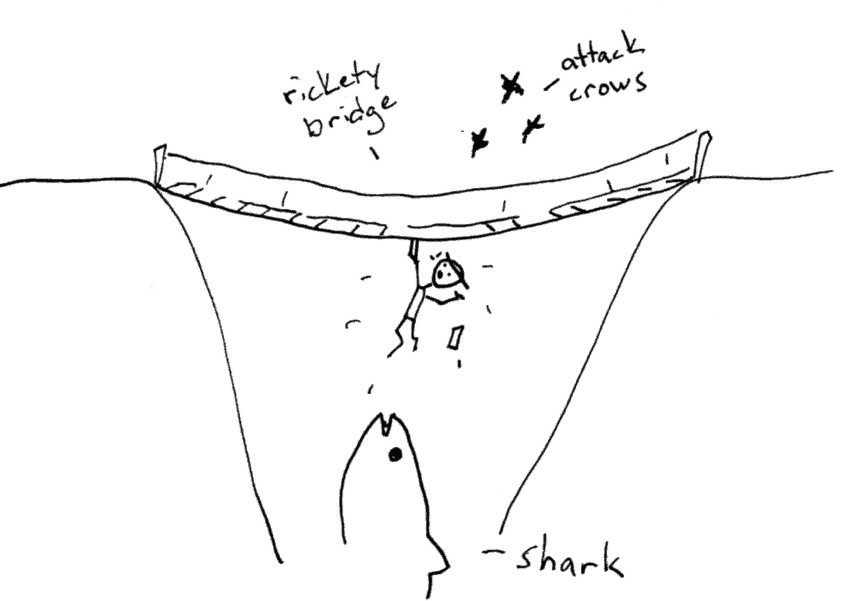
There’s got to be something that challenges the hero.
This usually involves either a set of circumstances (I want to quit my job but don’t have another source of income. I want the girlfriend but I’m overweight) or a villain.
6. The Villian
Darth Vader. Agent Smith. Thanos. Voldemort. The Joker (But only Heath Ledger’s Joker. Not Jack Nicholsons…)
Sometimes the villain IS the problem, and sometimes they create problems.
Marketing Takeaway…
Here’s a quote from StoryBrand:
If we want our customer’s ears to perk up when we talk about our products and services, we should position those products as WEAPONS they can use to defeat a villain. And the villain should be dastardly.
- Budgeting YouTuber? One-click shopping & “keeping up with the Jonses” might be your villain
- Keto blogger? SUGAR.
- Tesla? Gas-guzzling car manufacturers and their lobbyists.
What’s a villain you can talk about that’ll make your audience dread?
7. The Guide
Obi-Wan Kenobi and Yoda. Jack Dawson. Rafiki (and maybe Simon and Pumba?)
The guide exists to help the hero along their journey, giving them resources and a plan!
If your audience is the hero in their story, you (and your business) will be the guide.
8. The Plan
What Indiana Jones took one look at the Nazis and said “ehhh maybe I’ll just watch Netflix.”
That wouldn’t be a story at all. That’d be dumb.
No, the hero always needs a plan (sometimes given by the guide).
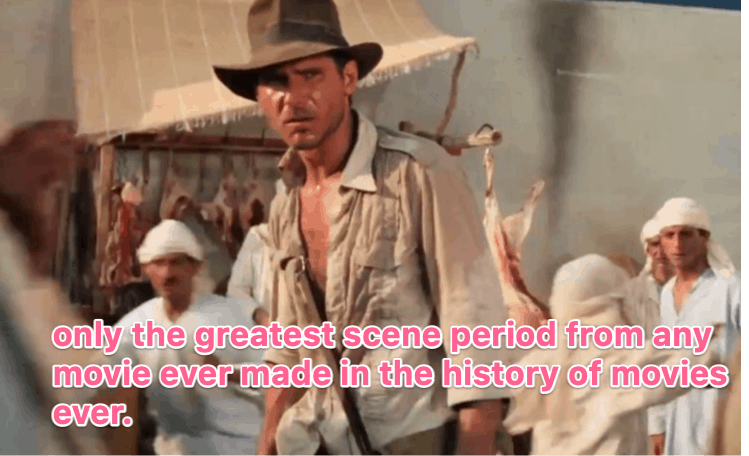
- Ok, let’s find where the Nazis are hiding my dad (by starting with that library in Venice)
- Let’s get Dad’s diary back (by impersonating a Nazi officer and going to Berlin)
- etc.
Sharing the hero’s plan keeps the audience engaged! They want to know “will this work? What will happen?”
The REALLY cool thing about problems, plans, and goals = you can constantly be overcoming problems and reaching goals….but you MUST create more! There must always be a chasm. The story gap can change and evolve.
9. The Incident
Denis Nedry shuts down power to the gate systems–and all the dinosaurs get loose.
It’s a turning point in Jurrasic Park.
“The incident” is usually an external event that motivates the hero to take action.
- The hero wants to lose weight and feel better about himself.
- He’s depressed and goes to buy four gallons of ice cream.
- Holding the ice cream, he bumps into his old high school crush, an attractive and fit yoga instructor.
- He is now motivated to lose weight.
10. The Happy Ending
Your audience should be able to picture what the hero’s life will look like AFTER they overcome the villain and save the day.
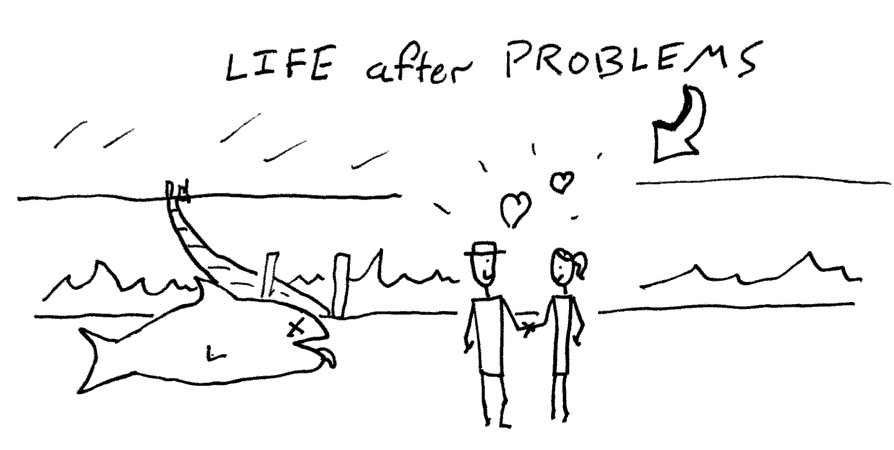
If there’s no happy ending, why is the hero even trying?
If you sell products, you should always position them as weapons to conquer villains and get a happy ending.
You should also get your customers to literally imagine what their life will be like after they’ve bought your product/service.
This is sales 101.
If you sell products, you should constantly be sharing what your customers
Brand Stories: What They Are and How to Use Em.
Now that we’ve seen some parts that we can pick/choose to assemble a story–let’s dive into how to USE these blocks.
And first up–the “brand story.”
What the heck do you mean by “brand story?”
This is a single, huge, overarching story that emcompasses EVERYTHING you communicate from your brand.
Your customer is the hero. You are the guide. Your product/service/brand helps your customers cross their chasms and progress on their journey!
Have you ever heard the term “WIIFM?”
WIIFM = What’s in it for me?
THAT’S what your website visitors, email subscribers, and potential customers are asking themselves ALL THE TIME.
Your customers do NOT care about you, your brand, or your products–as much as they care about their own journey towards their own goals.
Re-read that ????
Your readers are constantly assessing each communication you send out, trying to figure out “will this help me solve my problems and get what I want?”
- If you tell a story that makes them think “Yes,” they’ll listen.
- If you tell a story that makes them think “No,” they’ll tune you out.
We’ll detail how to use the story blocks from earlier to create your brand story just below.
After you create your brand story, use it across all your messaging.
Think of your one brand story like a coffee filter.
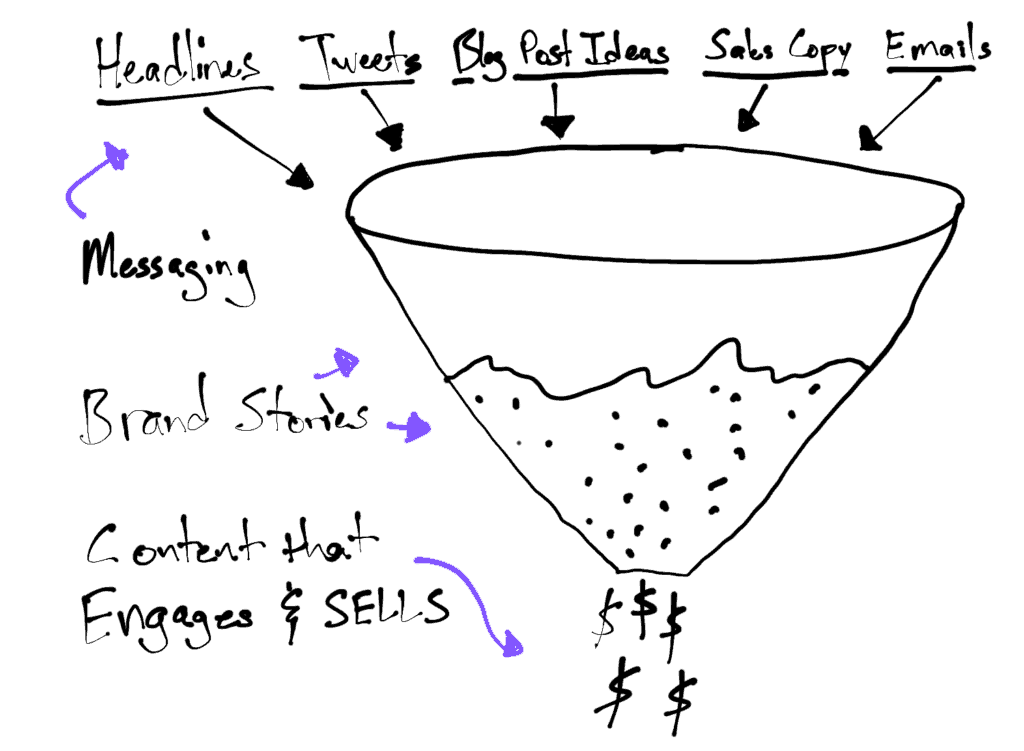
ANY and all content you produce should be “run through the filter” of your brand story.
- Does this YouTube video idea talk about any of my story lego elements?
- Does this sales copy talk about the HERO’s problems or villians? (I.e. your customers.)
- Does this launch email position ME and my products as the guide, rather than the hero?
All messaging coming from your business should pass through the brand story filter.
How to Create A “Brand Story.”
This is pretty simple.
Following the rules below, create each of the 10 story lego blocks. ????
1. Your customer is the hero.
Remember WIIFM from above? Your customer, listener, followers, and email subscribers are heroes in their own stories.
2. Figure out what your customer REALLY desires.
- My audience = to make more money doing fun things on the internet
- Personal finance audience = to have more money through investing or paying off debt
- Parenting audience = to be better parents who raise awesome kids with little stress.
All of those are EXTERNAL desires, but your followers want those things for internal reasons.
- My audience = they want online business success to feel like they’re capable and worthy, as well as financially secure.
- PF audience = they want to feel comfortable and not stress over money
- Parenting audience = they want to feel “right” in their parenting methods and like they “belong”
The hero of your brand story wants something. Figure out what that is, and position your products as a tool that helps them get what they want.
3. You, your biz, your products = the GUIDE (or the plan)
You are not the hero of your customers’ story. You are the guide.
Position your products as tools and resources your heroes can use to cross chasms, slay villains, and find success.
- Know your customers
- Figure out what they REALLY want
- Identify the key challenges keeping them from getting there
- Position your products as solutions to destroy those challenges
- Profit.
My easy formulas for coming up with examples & metaphors!
- Facts
- Dates
- Tidbits
- Detailed Instructions
People forget these easily.
- Stories
- Example
- Metaphors
These things are MUCH more sticky in our readers’ heads! Using examples and metaphors allows your audience to both digest information better, and remember it long after they’ve closed your website.
Formula: What’s the plan, and what’s the happy ending?
Here’s a foolproof plan for coming up with little examples or metaphors:
- Come up with the “plan”
- Come up with the “happy ending”
- Put it into a sentence
- Replace words
What’s the plan for your piece of content?
Example: Help people budget better.
- Plan = using a tool like YNAB to make things easier
- Happy Ending = stress-free budgeting that actually ends up with you having more money!
And if we put that in a sentence: “An affordable budgeting tool that isn’t stressful and saves you money.”
Now let’s replace words!
- An affordable tool that isn’t stressful and cuts your lawn.
- An affordable tool that isn’t stressful and recharges your phone
Right there, we have two silly examples we could create…
The end result from our budgeting post example:
I can’t STAND remembering to charge my phone.
My wife is constantly borrowing it (and moving it around the house), and I never remember to charge it at night. I’m also never at home during the day to charge it.
So I bought a portable charger. It was only $30, 100% portable, and has completed changed my happiness levels relating to charge my phone.
That’s what YNEB does for your budgeting.
Ok, so maybe that’s a mediocre metaphor, but I also made it up in 2 minutes ????
What’s the plan, what’s the happy ending? Put that in a sentence, start replacing words, and you can get some ideas for metaphors!
Formula: What’s the noun, what’s the adjective?
- What’s the noun?
- What’s the adjective?
- What else does this adjective apply to?
Noun = a thing, person, place, etc. The object.
Adjective?
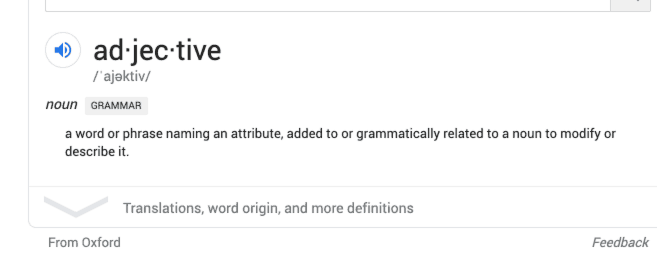
- Noun = car
- Adjectives = fast, slow, red, big, small, gaz-guzzling, efficient, etc
So what’s the THING you’re talking about? (YNAB in our example).
What’s an adjective that describes it? (cheap, easy to use, simple, powerful, effective)
What is something else those adjectives describe? (Let’s stick with “easy to use”)
A lightswitch.
YNAB is as easy to use as a lightswitch–i.e. my three year-old won’t stop messing with it.
Or something like that 😉
- Noun
- Adjective
- Something else that adjective also describes.
Boom! ????
One last example: Elementor
Elementor is incredibly powerful and cheap.
Elementor is the 1983 Ford Pickup truck of page builders – It’s affordable, insanely powerful, and will never let you down.
How’s that?
FYI – I actually believe that. Don’t miss my Elementor review & tutorial here!

